-
Posts
251 -
Joined
-
Last visited
Content Type
Profiles
Forums
Calendar
Posts posted by Drydock
-
-
If you want to keep Co2 levels high in your tank, just make sure their isn't a lot of splashing, that's how the Co2 disperses into the air.
You dont have to do an over flow box either.
you could plumb something to the top of the tank from the hole, and have water rush down it, but have it high enough, so if/when the power goes out the sump won't overflow.
Ya, I have a sump and I burned through my first 10 lb canister of C02 in 2 months... and that is AFTER I minimized the splashing in the tank and to the sump. If you can, fit a lid for your sump as well to keep the gas in. I'm hoping that my new adjustments will help me slow that one down and still run CO2 in the 20 ppm range.
I keep my overflow as high as I can without overflowing my tank, but then the fish swim through the egg carton grate
 So I have found a happy medium where there is as little noise, little cascade as possible.
So I have found a happy medium where there is as little noise, little cascade as possible.My drain pipe exits near the bottom of my sump so that it is below the surface level, minimizing splash. I use a bunch of pot scrubbers for bio media and then I have a T off my return that goes into a filter sock for polishing. It also helps you control the rate of flow back to the tank to balance with what your drain flow is.
The returns are all below the surface level in my tank, so they don't agitate the surface there. The problem is that in a power out situation, they will drain my tank into the sump. I have room for about 20 gallons of water in my sump, over and above the typical operating level if that happens. I would be inclined to run a return line outside the back of the tank and over the top and drill an anti-siphon hole in it. You can get check valves and what not, but everyone I talked to when I was setting up my tank says they will fail after a while and it's not a piece of equipment you can exactly rely on.
-
pH is 7.0 dKh is 8. According to the aquarium den, the CO2 is around 24 ppm.
It's an algae??? Learn something new every day...
-
UNBELIEVABLE!
So I make a nice couple of caves in a quiet corner of the tank for my kribs to breed in...
Exhibit A:
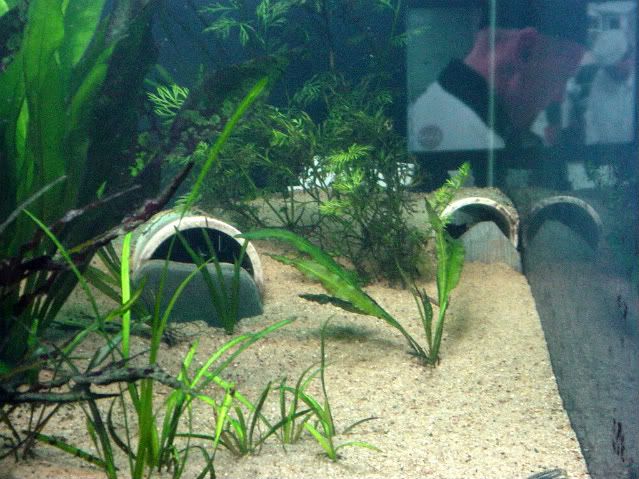
Nice location, big yard, close to good schools...
So where do they decide to go?
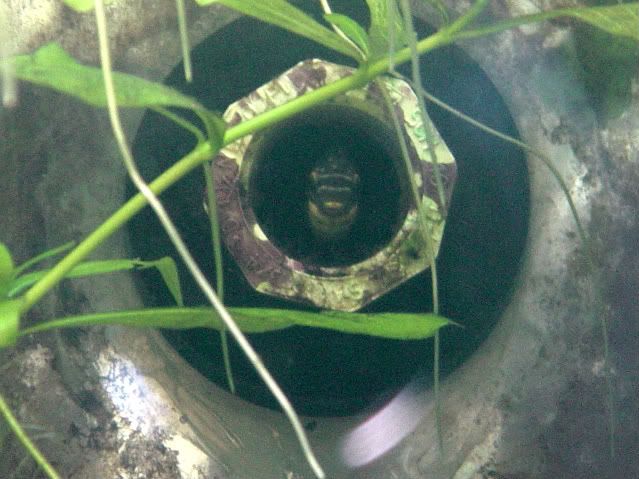
I have 3 returns in my tank - left, right and center. I only use the side ones, so the center one is closed. Apparently they like urban living and aren't afraid of heights.
This was the second spawn they had. The first ones didn't hatch, but this time I had a group of about 15-20 free swimmers for almost a week.
Here is a shot of two of my Male Rams facing off, which they do with some regularity. I have 6 (German Blue variety) in the tank and I THINK I have 4 males and 2 females.

-
The other option could be a residue that occurs when plants pull carbon from the carbonate in the water. However, that usually looks more like dust than scales.
Do you have a pH and hardness test kits? If so, you may want to see what your CO2 levels are (there's a CO2 chart online that's a measurement of pH and hardness - google CO2 chart, and you should find it pretty easily). If your CO2 levels are low (10ppm or less) the sword may be pulling carbon from the carbonate. I know you're pumping in CO2, but I also know that sumps have a way of dispersing the CO2 out of solution.
Yeah, that would be my guess too. The process is called Biogenic Decalcification. If you have plants like vals or elodea/egeria in your tank, you should see it on them too.
I don't have any elodea, right now it only shows on one leaf of my Osiris sword, and maybe a bit on 2 of the leaves the undulating crypt right beside it. I took a closer look this morning and it doesn't seem to be on my vals, the other two swords in my tank or anything else..
Here is the best photo I could get. You can see the one leaf from the sword and the crypt in the lower right. I tried to scrape some of it off. I definitely does not just brush off. Seems pretty well rooted, but I can get it off.
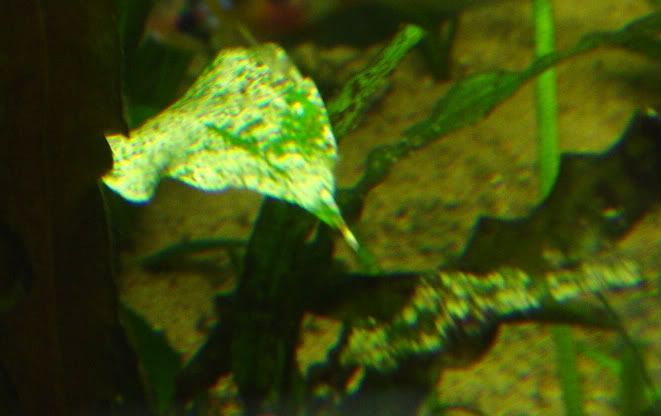
Thanks for the link Werner... I didn't understand it all, but I get the gist of the reaction that is taking place. It sounds like if I get some snails, they will use up the free carbonate and then it won't precipitate out on my plants... but I probably need like a million of them.

I'll check my pH and hardness tonight when I get home.
-
Hmm... I've never seen that before, but I have a couple guesses. My 1st guess would be algae - there are all kinds out there, so even though I haven't seen something like you're describing doesn't mean it's not algae. I have had some rough, greenish algae on my swords before, but it wasn't really scaled.
The other option could be a residue that occurs when plants pull carbon from the carbonate in the water. However, that usually looks more like dust than scales.
Do you have a pH and hardness test kits? If so, you may want to see what your CO2 levels are (there's a CO2 chart online that's a measurement of pH and hardness - google CO2 chart, and you should find it pretty easily). If your CO2 levels are low (10ppm or less) the sword may be pulling carbon from the carbonate. I know you're pumping in CO2, but I also know that sumps have a way of dispersing the CO2 out of solution.
Ya, I basically pump CO2 to get rid of algae... I am sure it is low. I also turned it up tonight because I was having some more algae growth on my sand. It didn't look like it was pumping at all. I turned it way down because I burned through 10 lb in 2 months...

I'll see if I can post a photo later.
-
Hi,
I noticed on one of the leaves of my Osiris Sword that the top 2/3 of the leaf is covered in a hard light scale... almost like a hard water scale. it is quite rough and off white in color. I have no idea why... anyone else experienced this?
I am using the EI for ferts... 3 tsp, 3x per week for KNO3 and I tsp, 3x per week for trace, and the other two. in 250 gallons and a heavily planted tank.
Any ideas?
-
-
Boom,
If you are going to go for a bigger diameter drain, I would go 2". Just my opinion.
One thing i just thought of was your return pipe. I have a short length of flexible pipe coming out of my pump, before I go to PVC to prevent the pump transmitting vibration to the main tank. During your test, did you notice if that was an issue?
-
I run my tank at 82 degrees for my rams...
I have Osiris swords, pygmy chain, red tiger lotus, java fern, vals, and another stem plant...
They all grow like weeds now that I am running CO2 and EI. I have had problems with several plants that didn't like the higher temperature for sure...
-
Lookin' good Boom. Keep the pictures coming.
-
Just buy a bigger tank, then you don't need the smaller spoons!

-
DaveDude 77,
You can take multiple bulbs with smaller wattages and add them together. You don't need 500 watts coming out of one bulb. (You probably shouldn't either)
The T5HO are a great idea, but you are right, they are money.
You can go to Home Depot and get a T8 4 bulb shop fixture and then put the phillips aquarium and plant bulbs in there ($8 each?) I used a 2 bulb shop light on my 72 gallon and had good plant growth. I am thinking of the 4 foot bulbs...
You would probably need 2 of those setups, but it would be a far cry from $1500 (Maybe even less than $200)
T5 or T8 is the size of the bulb. T12 is what you see in most commercial applications for fluorescent lights in the ceiling. T8 is a 'thinner' tube and is also more efficient, but you need a T8 ballast to run it. They are easy to find, even if you wanted to retrofit an older canopy, but you cant just throw in T8 bulbs in a T12 canopy, that's all.
T5, as I understand, is even smaller and even more efficient, but require their own type of fixture.
-
amazing tank! thats so huge! my biggest is a 120 and this one dwarfs it. i really like how you thought of semi-water proofing the stand in case of a leak, i never would have thought of that. also if your still looking for a sweet centerpeice fish then i would recomend discus, or one of my personal favorites, the black ghost knife. black ghost knifes can get quite large (15-20 inches) and will devour smaller fish in the night time (mostly neaon tetras and the like, but i can't find a few guppies.....) but if you are planning to not keep the tinier fish then i think it its one of the most interesting fish to watch.
The smallest fish in their right now would be one of the rasboras, and he is a good 1.5". Probably the biggest one I have ever seen...
I don't want to commit to the work you need to do for discus, but I did consider a knife for a while.
-
It would be something that requires a dingy to do maintenance on...

-
That is a tiny sump, does it work well though??
TINY? Tell my wife that! According to her, there isn't anything tiny about this project.
The sump is 57 gallons, based on the inside dimensions... 34" Long, 17" wide 25" high
I generally have it about 1/2 full so figuring 25 gallons which is only 10% of tank volume... technically, maybe a bit small.
I think I get away with it b/c the tank is heavily planted and my bio load is very low for a tank this size. (for now)

If I add more fish, I may need to add another form of filtration, but no plans yet.
-
You've got it exactly right.
Thanks Jason, it makes alot of sense to do it that way. I'll go for it. I assume you just have that diverted pipe going back into the pump area of the sump, and not send the water back through the filter media again?
I guess you could do either. Your choice. Here are some photos of my sump setup.
-
if I understand the bypass loop on the return, I would place a T in the return line, with a pipe going back into the sump, that pipe is where I would place the ball valve, instead of in the return line itself, right? Then I could control the flow going back into my tank, by opening or closing that ball valve, letting more or less water from the return divert back to the sump, with putting additional back pressure on the pump. Is that correct? Seems to make sense. If I have it right, I think I'll do that.
You've got it exactly right.
I have 2 ball valves on my return: one on the way up to the tank and one after the T.
For the most part, the valve on the main return stays wide open, but I do close it if I turn the pump off during water changes. It would stop any suction through the return lines as mine are below the water level
-
very nice...
-
Here are some photos of the sump setup I am running right now. So far, it seems to be working well.
Here is a shot of it empty so that you can get a good look at the baffles.
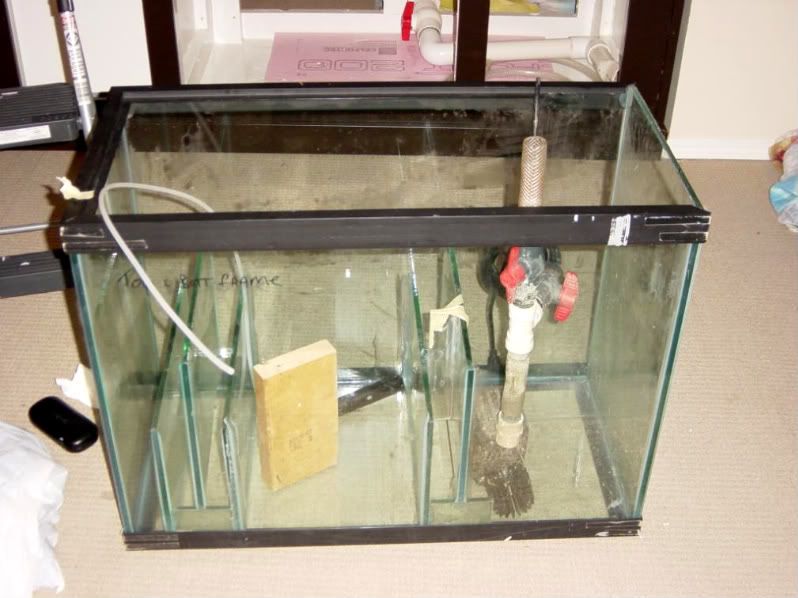
Here is what it looks like running.
Left Side (return side)

I am using a 100 micron filter sock off the return loop to add some mechanical filtration. I had originally had it on the drain into the sump, but it clogged too quickly and I was changing it every day. Now, I am changing it out and washing it every other day.
to wash it, I rinse it inside out to get off as much as I can, then wait until my wife is out to sneak it in the washing machine - no soap, just bleach...
Right side (drain side)
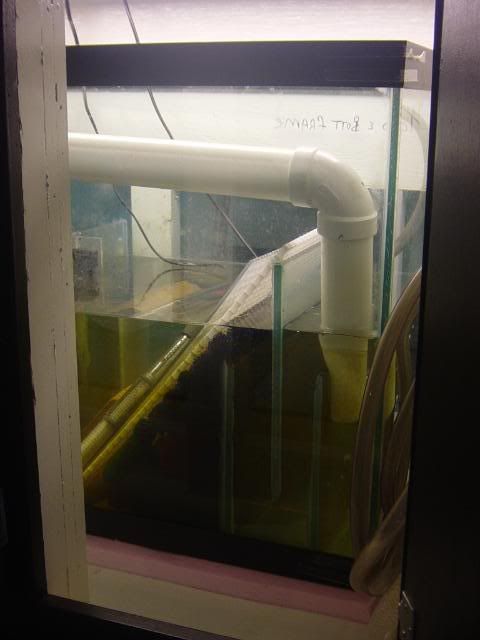
In the middle section, I have plastic pot scrubbies and some bio balls I found for free. Too bad they all float! I weighed them down with some egg crate and I also added a piece of plexi on top of that, about an inch off the bottom to force most of the water to flow through the media and not just across the top. It gives me a great place to attach my heaters as well. They have their own space and I don't have to worry about melting plastic or anything.
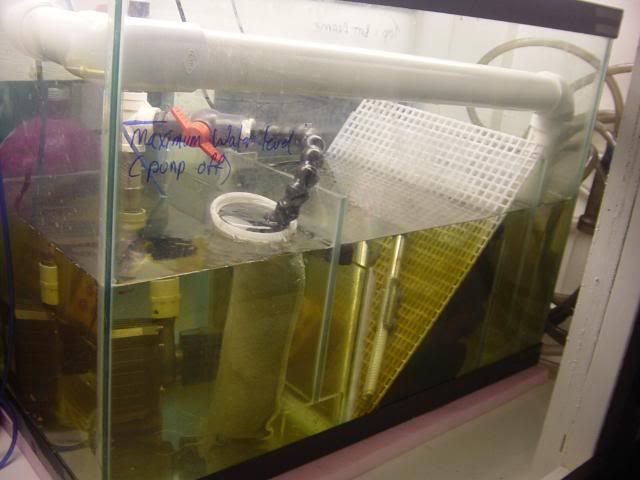
I did try and grow some java moss in there, but gave up on that idea.
I have the cabinet doors done finally, but I lost the photo. I'll get a new one up later on.
Here is a shot of a couple of the rams. They are cool. Very personable and I have 6, so there are a couple of pairs, but lots of room to run and hide, so no one is really getting beaten up on. The males will all flare out and circle each other, except for when I happen to have a camera in my hand. Someday, maybe I'll get the hang of taking photos of them...
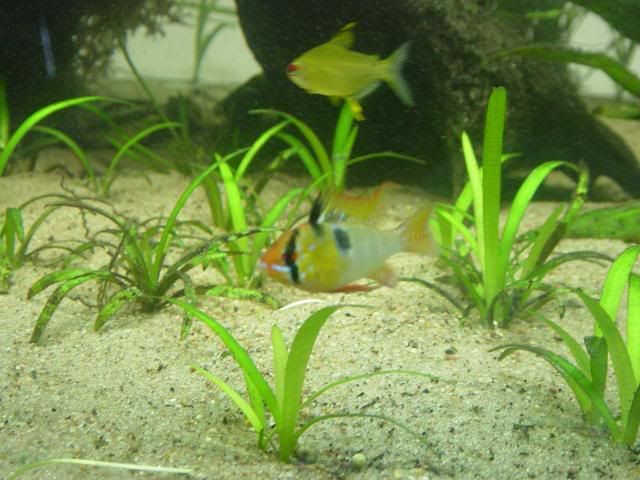
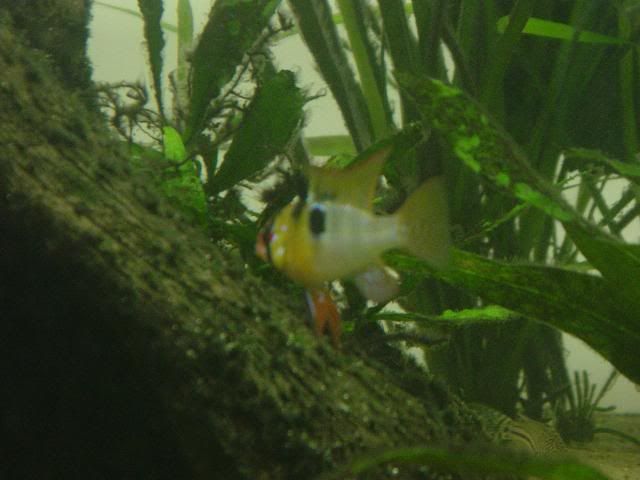
-
O.k. So I did some research on the auto top off systems. If I understand correctly it just uses a float valve to determine when you've lost x amount of water due to evaporation, then adds water to get back to a proper level. Correct?
I'm thinking that with a glass lid completely covering the tank, and a lid on the sump as well, I'm not gonna loose enough to evaporation in between water changes to make this worth while.
On my 55 with a not as tight fitting lid, I barely loose enough water to even notice over a 2 week period. I know the surface area of a 180 is much larger, but the glass lid will be tighter fitting as well.
Am I wrong or missing something re. the top off system?
Nope, that's basically how they work. Some people plumb in their R/O system to feed the top off water, or you can use a smaller container that has a pump in it or just gravity fed. My 210 is 72"x30" for surface and I have a tight fitting glass lid. I lose 5 gallons every 3 or 4 days. My sump does not have a lid on it, so that contributes for sure.
-
Roger, quick question, with putting the heater in the sump, how do I determine what size heater I need?
I agree and disagree with Firestorm. Your return pump will add heat, but you are still heating 210 gallons. The fact that it is flowing through the sump, where your heater is, works both for you and against you. The sump is a smaller size, therefore needs fewer watts to heat, but it is turning over its volume 42 times an hour (at 1400 GPH flow) and is constantly being diluted with (theoretically) cooler water. You also are having this in your basement. What is the difference in the average room temperature and the temp you want for your tank? I have always added extra wattage for my tanks in the basement, especially in the winter.
Run your setup with just the pump on and see what stable temperature you get, then see how many degrees from the ambient temperature you need to go up. If it is only 2 or 3, then maybe a 200 W would be fine. More than that, I think you should go bigger. Just make sure it actually fits into the sump... (don't ask)
Regarding the ATO...
You won't notice evaporation changing the level in your display tank, it will show up in your sump. If you are running a heater in the sump, try not to put it in the same compartment where your pump is. I am assuming there are some baffles in their so that water can't go straight through. When your water level starts to drop, due to evaporation, that compartment is to one that goes first and you could find a plugged in heater sitting higher out of the water than it should. The ATO helps minimize some of this. With my setup, I don't have a lot of room to add buckets of water in the top of the tank, or the sump, so if you hat a smaller container that you could remove and replace, it would be a good idea.
I still would plumb in the bypass loop on the return... IMHO
-
Boom,
Looks good man. I just finished almost the same project. My tank was already drilled and had the plumbing installed, but I had to build a stand and redo a lot of the plumbing underneath. I did learn a few things along the way that might be helpful...
I found it was a pain to learn how to use it, but it is worth it. I have my heaters, and CO2 all in the sump so I have a nice clean display. I also add all my dry ferts in the sump and they are dissolved before they make it into the display tank.
Before you install those ball valves, get some silicone lubricant in there and get them moving really good. I have those valves on my sump and they seize up real nice... You can get a really small tube from a very large box LFS on 99th st. that does not happen to be a sponsor here, but for the same price, I ordered some from a place in the states and got like 10 times a much. Maybe call Kelly at the Reef Shoppe and see if he has any. I'm not sure where else in the city you can find it.
I also learned (the hard way) that you will need to fool around with adjusting your flow to and from the sump so that you get an equilibrium. The easiest way I found to do that is to plumb in a T with a line that goes back into your sump. Stick a valve on there as well and you can turn down the flow going into your tank by diverting some back into the sump. You will also avoid putting unnecessary head pressure on your pump when you are trying to balance it with your drain flow going into the sump. (I also run a 100 micron filter sock on here for some extra mechanical filtration.) Originally, I had the filter sock on my drain, right as it went into the sump but it was clogging up every single day and then playing havoc with the flow to and from the tank.
What are you going to put in the tank? I have my 210 set up as a planted tank with a lot of smaller fish - congos, rainbows, rams, gouramis... I found that I was getting too much flow and too much velocity out of my returns. 1900 GPH is definitely lots, but it may be too much... maybe not. (1900 GPH on a 180 is 10x per hour of the total volume. I thought 3-5 was how they 'rated' filters) I turned my velocity and GPH down by using the loop back into the sump I described above. Also, as your media collects detrius, it will slow down the flow. It might be a good idea to make sure that there is a path that water can flow through the sump without going through the media if it starts to get to soiled and slows down.
Are you going to set up auto top off? I didn't and I regret it now... Think about it.
Roger
-
I would tend to agree, bigger is better, but it would still have to be properly decorated to suit the species as well. If you have a totally bare 350 gallon thank, only certain fish are going to be happy in there.
-
I have 4 - 96W 12,000K and 4 - 96W Atinics and my plants are growing like crazy...
I don't turn all of them on at the same time... 1 hour atinics in the morning, leading into 9 hours of the 12,000 with the atinics off.
Lol, I can see why your plants are growing like crazy. You have alot of wattage on there. What size of tank is that again?
It's a 210. 72" long 24" deep and 30" front to back... It was originally a reef setup, but I wasn't ready to start a SW tank. Running the lights on the current schedule, I am just under 2 WPG, but I gain some advantage that the tank is not as deep as a normal 210 or 240.
I started with CO2 and I am using EI for ferts. All dry salts that I add every other day...



Advice on building a sump/ wet dry filter
in Do-it-yourself
Posted
My CO2 line goes into the intake of my return pump. That way, the impeller diffuses the bubbles into tiny bubbles and they get deposited directly into the tank. The water returning to the tank should have the highest concentration of CO2 (Theoretically) It also saves me from having a powerhead or diffuser in my display tank.
The challenge is, that standing water has a CO2 level of about 3-5 ppm. As the water gets agitated, even going down your drain pipe, dumping into the sump, and anywhere you would get cascade, you will have CO2 being released out of the water. So yes, best place to add CO2 is the return pump, but a lot of what you are trying to accomplish will get stripped out as water enters your sump.